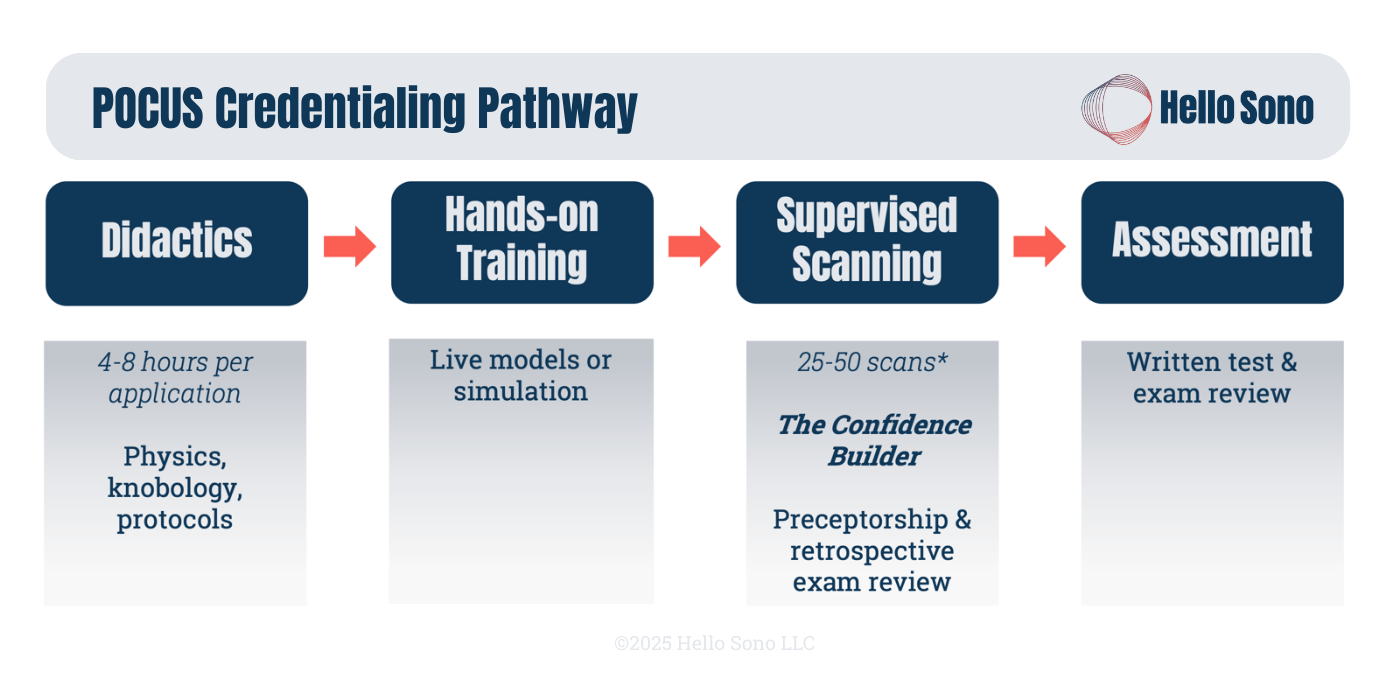POCUS Credentialing: What Every Primary and Urgent Care Practice Needs to Know
Point-of-care ultrasound (POCUS) is one of those tools that, once you start using it, you can’t imagine practicing without it. But here’s the challenge: taking a course or workshop is just the beginning. The real challenge is moving from initial exposure to credentialed, consistent practice.
So what does that pathway look like? Let’s break it down.
Why Credentialing Matters:
Credentialing isn’t about paperwork—it’s about patient safety, consistency, and provider confidence. Standards from organizations like ACEP, AAFP, and AIUM exist so providers can:
Feel confident their skills meet the bar.
Keep patients safe with accurate, reproducible scans.
Show proof of training if payers or administrators ever ask.
Think of credentialing as the bridge between “I took a course” and “I use POCUS every day with confidence.”
The Four Steps to POCUS Credentialing:
Didactics
Start with the basics: physics, knobology (yes, all those buttons), image interpretation, and clinical integration. Most of this is done through online modules or courses.Hands-On Training
Ultrasound is a physical skill. That’s why most pathways recommend a workshop or simulation. Feeling the probe in your hand and adjusting in real time makes all the difference.Supervised Scanning (The Confidence Builder)
Here’s where skills turn into confidence. It is recommended that learners complete a minimum of 25 scans per application (fewer for procedures, usually 5–10). Ideally, this happens with a mentor at the bedside. But since that’s not always available, retrospective exam review by an expert is the most practical route.ACEP and AAFP both recommend including some pathology when possible. If it’s rare, simulation or case studies can help fill the gap.
Assessment
Finally, providers need to demonstrate competency in image acquisition and interpretation. This might be a written test, question bank, OSCE-style exam, or reviewed case log.
What About Advanced Practice Providers (APPs)?:
Both ACEP and AIUM recommend that nurse practitioners (NPs) and physician assistants (PAs) follow the same training and competency standards as physicians. This ensures consistency across the care team and keeps patients safe while expanding access to POCUS in primary care, emergency medicine, and urgent care settings.
Credentialing vs. Certificates:
It’s important to understand the difference between the two:
Credentialing = Internal. Your institution sets standards for competency for specific POCUS applications depending on resources. It then grants you the privilege to perform POCUS clinically after you’ve met the standards.
Certificates = External. A workshop or an online course with assessment can give you a certificate of completion, but that’s not the same as being credentialed.
If your institution has qualified POCUS educators and the infrastructure, POCUS credentialing can be completed within the institution without external certificates. But if those resources don’t exist, certificates can be a useful way to demonstrate training and help achieve credentialing standards.
Keeping Skills Sharp:
Credentialing isn’t a one-time event. Best practice includes:
Reviewing 5–10% of exams annually for quality assurance.
Maintaining CME or didactic learning to keep up with evolving standards.
Performing a minimum number of scans each year to ensure continued utilization and skill retention.
Credentialing takes time, but it’s worth the effort. It ensures providers can perform high-quality scans they can rely on for clinical decision-making. The process combines structured didactics, hands-on training, supervised scanning, and assessment.
And remember: while national guidelines set the framework, each organization should design a credentialing protocol that fits its own resources, workflows, and patient needs.
Ready to take the next step with POCUS?
Hello Sono helps practices roll out high-quality, compliant, and profitable POCUS programs.

